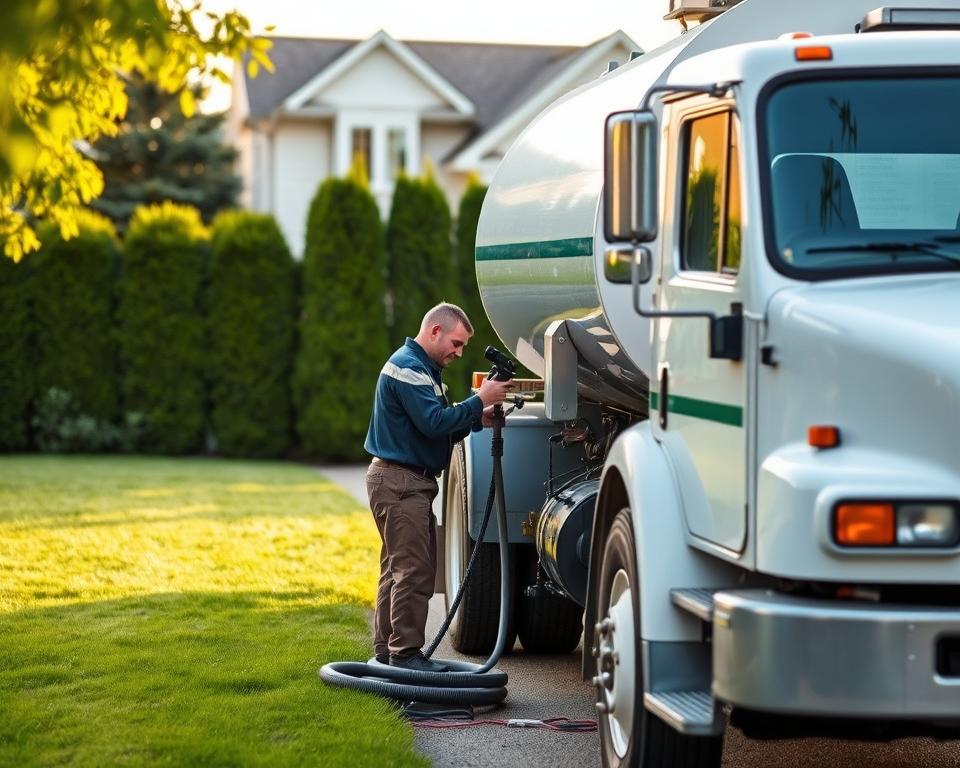Septic Air Pump: Complete Guide for Property Owners
Do you sometimes think about what drives your oxygen-based Septic system’s efficiency? The Septic tank aerator is the unrecognized key component integral for your system. In this article, readers will get essential information on the air Pump’s importance. It’s essential for a sound, optimized Septic system.
Appreciating the importance of a Septic tank air Pump can optimize your Septic system’s capabilities using septic tank pumping service near me. It also secures your home equity and ecological well-being. This guide will present All in Sanitation, a well-regarded Septic industry leader. They’re eager to fulfil your Septic aerator Pump needs.
Primary Points
- The Septic air Pump is paramount for oxygen-based Septic setups.
- Looking after your Septic system air Pump can enhance overall system performance.
- Periodic reviews lengthen the lifespan of your Septic tank air Pump.
- Opting for the best-fit Septic aerator Pump is essential for top operation.
- All in Sanitation supplies tailored services for Septic air Pump needs.
Exploring Aerobic Septic Systems
Aerobic Septic systems deliver a more effective waste treatment approach by using oxygen. This method relies on aerobic bacteria operating in well-oxygenated environments. These bacteria are highly effective in processing organic matter. With the help of Septic aerator Pumps, these systems deliver a continuous oxygen supply, accelerating the waste decomposition process.
These systems excel in minimizing sludge buildup, owing to the efficiency of aerobic bacteria. This drop in solid waste means fewer service calls and tank emptying is necessary. Additionally, they successfully handle wastewater, leading to reduced odors. This ensures a more pleasant environment for homeowners and the community overall.
To ensure these systems work efficiently, it’s essential to grasp the key Septic system components. These include the Septic tank, oxygenation chamber, and effluent Pump. Each section has a crucial role, especially the air Pump. It drives oxygen into the tank, crucial for the aerobic bacteria’s performance.
Role of the Septic Air Pump
The Septic air Pump is pivotal in the functioning of aerobic Septic systems. It serves as the system’s “air provider,” delivering the critical oxygen essential. This oxygen enables aerobic bacteria to operate efficiently and digest waste effectively. If the Pump stops, the system’s efficiency decreases, leading to sludge buildup and possible odors.
Such issues can hamper Septic system operations and lead to environmental hazards. By understanding how important the Septic air Pump is, homeowners can act preemptively. They can ensure its top function through scheduled service. This stops failures, sidesteps costly repairs, and maintains the aerobic system’s integrity.
Top Advantages of Using a Septic Air Pump
Utilizing a Septic air Pump markedly increases the performance of Septic systems. Septic air Pumps are vital as they speed up the processing of waste. This is achieved by oxygenating the treatment process, promoting aerobic bacteria growth. These bacteria are vital for successful waste treatment.
They’re also important in reducing foul smells. Because of more active aerobic processes, waste breaks down faster, thus cutting down odors. This provides a fresher environment for homeowners.
Another valuable benefit is the cut in sludge collection. Consequently, tanks demand less frequent Pumping, cutting both money and time. Better processing not only cuts expenses but also increases the lifespan of the drain field.
Proper care of these Pumps diligently means less frequent repair costs and complying with regulatory standards. Thus, the advantages of Septic air Pumps go beyond being for homeowners. They also benefit environmental health by improving waste management practices.
| Benefit | Description |
|---|---|
| Fast Waste Breakdown | Increased aerobic activity hastens the decomposition process. |
| Minimized Odor Emissions | Optimized treatment efficacy produces fewer odors. |
| Reduced Sludge Buildup | Fewer Pumping and maintenance are required. |
| Extended Drain Field Life | Better treatment equals a healthier drain field. |
| Cost Savings | Lower likelihood of repairs and regulatory compliance cost. |

Finding a Suitable Septic Air Pump
Opting for the best Septic air Pump is vital for an efficient aerobic system. Homeowners must consider various factors for the best fit. The dimensions of the tank and the airflow requirements play a crucial role the Pump’s output.
To make an informed choice, it’s useful to understand the air Pumps available. There are mainly two types: diaphragm Pumps and rotary vane Pumps. Each provides distinct advantages, which should be paired with your home’s individual circumstances and operational profile.
Energy use also matters. Selecting a Pump that minimizes energy use while achieving the needed airflow can yield meaningful reductions. Assistance from All in Sanitation professionals can be priceless. They make certain the Pump you choose fits your system’s requirements exactly.
Common Types of Septic Air Pumps
Homeowners can decide more effectively by understanding the different Septic air Pumps available. There are mainly two types: diaphragm Pumps and rotary vane Pumps. Each has its particular functions and benefits.
Diaphragm Pumps, famous for their silent operation, are commonly used for residential Septic systems. They deliver energy efficiency while ensuring stable air output. Their constant performance matches smaller systems, attracting many homeowners.
Rotary vane Pumps, however, are ideal for extended or commercial systems. These Pumps produce higher capacity, necessary for handling bigger loads. Their strong build delivers efficient operation in heavy-duty Septic systems.
| Type of Pump | Best Use | Advantages |
|---|---|---|
| Diaphragm Pumps | Residential Systems | Quiet operation, energy-efficient, reliable air flow |
| Rotary Vane Pumps | Larger or Commercial Systems | Powerful performance, high capacity, durable construction |
Knowing the variations in Septic air Pumps is key for upgrades or replacements. Each Pump type offers specific features to satisfy various needs. This guarantees optimal performance for any system.
Clues Pointing to a Septic Air Pump Replacement
Homeowners must be alert to Pump failure signs in their Septic systems. Some indicators point towards the need for a Septic air Pump replacement. These keep the system running smoothly. Catching these promptly prevents major issues.
Signs of potential problems include:
- Unusual noises from the Pump, like rattling or trembling, might suggest internal damage.
- A clear lack of air output indicates the Pump isn’t functioning properly, impacting efficiency.
- Frequent electrical problems, such as power trips or power dips, could point to overloading.
- Visible damage on the Pump unit, with fractures or leaks, calls for quick action.
- Unpleasant odors in the yard often indicate a compromised Pump, highlighting ineffective effluent aeration.
Detecting these signs early avoids pricey restoration or total system failure. Carrying out periodic reviews helps identify these issues. It also confirms if you should get a new Septic air Pump.
Care Guidelines for Your Septic Air Pump
For an efficient Septic air Pump, consistent service is essential. This guarantees that your system functions properly. Homeowners can use several practical care strategies for maximum results.
Twice a year, conduct a careful inspection for wear or damage. It is also important to change the filters as advised. This stops clogs that could hurt efficiency.
The Pump should sit on a firm base to cut vibrations, which could affect it over time. A protective cover is essential too. It protects against debris and water, maintaining the Pump’s functionality.
Regular servicing can notably extend the life of your Pump. In turn, this supports the Septic system’s performance in general.
| Maintenance Task | Frequency | Benefits |
|---|---|---|
| Inspect Pump for damage | Every 6 months | Identifies issues early |
| Replace filters | As needed | Enhances operation |
| Check surface stability | Annually | Limits wear |
| Clear debris around Pump | Monthly | Avoids obstruction |
Fitting Your Septic Air Pump
Correct installation of your Septic air Pump is vital for its optimal operation. At the outset, find a stable, moisture-free area for placement. The chosen spot should firmly hold the Pump’s weight without strain.
To properly set up your Pump on your own, observe the following guidelines:
- Assemble all necessary items, including the Pump, a power source, and hose fittings.
- Check the manufacturer’s guidelines before beginning your installation.
- Confirm every connection is proper to eliminate air leaks that reduce performance.
- After assembly, run a test to confirm the system works as intended.
If the installation process looks challenging, contact All in Sanitation. Their professionals can sidestep common errors, making sure your setup follows strict safety requirements.
Advantages of Using All in Sanitation for Your Septic Air Pump Services
When choosing a Septic service provider, the choice is key. All in Sanitation separates itself by supplying dependable Septic air Pumps. They address different homeowner requirements with a wide selection of high-grade products. This means customers discover an appropriate match for their Septic systems.
What clearly distinguishes All in Sanitation is more than their extensive product lineup. Their dedication to exceptional customer service is also critical. Homeowners get expert advice, leading them to trusted Septic solutions. This teamwork is essential to tailor each solution to meet specific needs.
All in Sanitation also prioritizes aftercare to ensure lasting satisfaction. Their devotion extends beyond the initial sale. They offer ongoing support to maintain Septic systems running smoothly for the long haul.
Budget Factors for Septic Air Pumps
Appreciating the price factors tied to Septic air Pumps is essential for homeowners using aerobic Septic systems. At first, one faces the initial cost, which includes the Pump and needed accessories. Installation expenses differ, based on the system’s complexity and any changes required.
Ongoing upkeep forms an additional cost layer. Routine checks can head off bigger issues, ultimately leading to savings. Homeowners should set aside funds for Septic maintenance to retain the Pump’s effectiveness and longevity. Such planning prevents expensive repairs later on, illustrating the value of proactive maintenance.
| Cost Component | Average Cost Range |
|---|---|
| Septic Air Pump | $500 – $1,200 |
| Installation | $300 – $800 |
| Annual Maintenance | $150 – $400 |
| Potential Repair Costs | $1,000 – $5,000 |
Dividing Septic air Pump expenses into specific parts helps homeowners in budgeting. This detailed approach ensures the system’s consistent operation and their confidence.
Bringing It All Together
For homeowners with aerobic Septic systems, caring for Septic tanks is key. The proper Septic air Pump enhances waste processing and prolongs your system’s life. Committing to consistent service and swiftly handling issues stops expensive repairs and disruptions.
Picking a Septic air Pump requires careful thought. This guide highlighted how to choose wisely about installation and replacement. With All in Sanitation’s help, you can handle your Septic systems’ complexities confidently.
Taking care of your Septic air Pump supports your system’s performance and durability. It provides a efficient and optimal operation over time. Bear in mind, your home’s wastewater management relies heavily on consistent upkeep.


